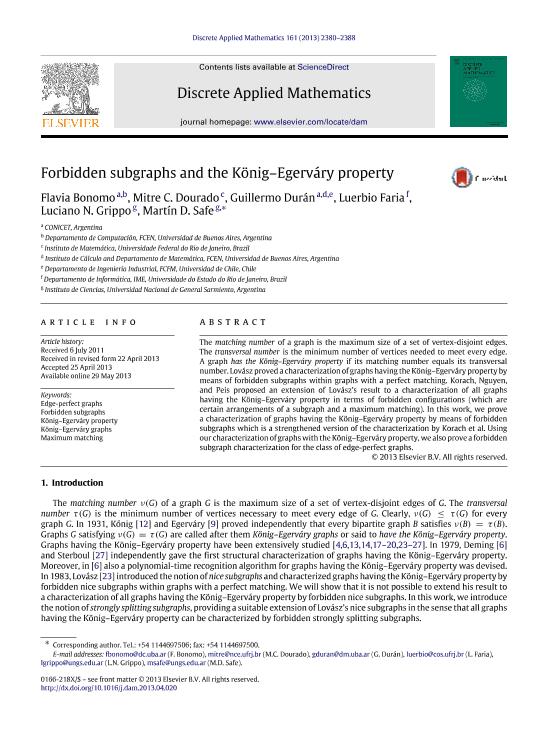Mostrar el registro sencillo del ítem
dc.contributor.author
Bonomo, Flavia

dc.contributor.author
Dourado, Mitre C.
dc.contributor.author
Duran, Guillermo Alfredo

dc.contributor.author
Faria, Luerbio
dc.contributor.author
Grippo, Luciano Norberto

dc.contributor.author
Safe, Martin Dario

dc.date.available
2017-06-23T21:50:19Z
dc.date.issued
2013-11
dc.identifier.citation
Bonomo, Flavia; Dourado, Mitre C.; Duran, Guillermo Alfredo; Faria, Luerbio; Grippo, Luciano Norberto; et al.; Forbidden subgraphs and the König–Egerváry property; Elsevier Science; Discrete Applied Mathematics; 161; 16-17; 11-2013; 2380-2388
dc.identifier.issn
0166-218X
dc.identifier.uri
http://hdl.handle.net/11336/18841
dc.description.abstract
The matching number of a graph is the maximum size of a set of vertex-disjoint edges. The transversal number is the minimum number of vertices needed to meet every edge. A graph has the König-Egerváry property if its matching number equals its transversal number. Lovász proved a characterization of graphs having the König-Egerváry property by means of forbidden subgraphs within graphs with a perfect matching. Korach, Nguyen, and Peis proposed an extension of Lovász´s result to a characterization of all graphs having the König-Egerváry property in terms of forbidden configurations (which are certain arrangements of a subgraph and a maximum matching). In this work, we prove a characterization of graphs having the König-Egerváry property by means of forbidden subgraphs which is a strengthened version of the characterization by Korach et al. Using our characterization of graphs with the König-Egerváry property, we also prove a forbidden subgraph characterization for the class of edge-perfect graphs.
dc.format
application/pdf
dc.language.iso
eng
dc.publisher
Elsevier Science

dc.rights
info:eu-repo/semantics/openAccess
dc.rights.uri
https://creativecommons.org/licenses/by-nc-nd/2.5/ar/
dc.subject
Edge-Perfect Graphs
dc.subject
Forbidden Subgraphs
dc.subject
König-Egerváry Property
dc.subject
König-Egerváry Graphs
dc.subject
Maximum Matching
dc.subject.classification
Matemática Aplicada

dc.subject.classification
Matemáticas

dc.subject.classification
CIENCIAS NATURALES Y EXACTAS

dc.subject.classification
Ciencias de la Computación

dc.subject.classification
Ciencias de la Computación e Información

dc.subject.classification
CIENCIAS NATURALES Y EXACTAS

dc.title
Forbidden subgraphs and the König–Egerváry property
dc.type
info:eu-repo/semantics/article
dc.type
info:ar-repo/semantics/artículo
dc.type
info:eu-repo/semantics/publishedVersion
dc.date.updated
2017-06-23T14:17:31Z
dc.journal.volume
161
dc.journal.number
16-17
dc.journal.pagination
2380-2388
dc.journal.pais
Países Bajos

dc.journal.ciudad
Amsterdam
dc.description.fil
Fil: Bonomo, Flavia. Universidad de Buenos Aires. Facultad de Ciencias Exactas y Naturales. Departamento de Computación; Argentina. Consejo Nacional de Investigaciones Científicas y Técnicas; Argentina
dc.description.fil
Fil: Dourado, Mitre C.. Universidade Federal do Rio de Janeiro; Brasil
dc.description.fil
Fil: Duran, Guillermo Alfredo. Universidad de Buenos Aires. Facultad de Ciencias Exactas y Naturales. Instituto de Cálculo; Argentina. Universidad de Chile; Chile. Consejo Nacional de Investigaciones Científicas y Técnicas; Argentina
dc.description.fil
Fil: Faria, Luerbio. Universidade do Estado do Rio de Janeiro; Brasil
dc.description.fil
Fil: Grippo, Luciano Norberto. Universidad Nacional de General Sarmiento. Instituto de Ciencias; Argentina. Consejo Nacional de Investigaciones Científicas y Técnicas; Argentina
dc.description.fil
Fil: Safe, Martin Dario. Universidad Nacional de General Sarmiento. Instituto de Ciencias; Argentina. Consejo Nacional de Investigaciones Científicas y Técnicas; Argentina
dc.journal.title
Discrete Applied Mathematics

dc.relation.alternativeid
info:eu-repo/semantics/altIdentifier/doi/http://dx.doi.org/10.1016/j.dam.2013.04.020
dc.relation.alternativeid
info:eu-repo/semantics/altIdentifier/url/http://www.sciencedirect.com/science/article/pii/S0166218X13002072
Archivos asociados
